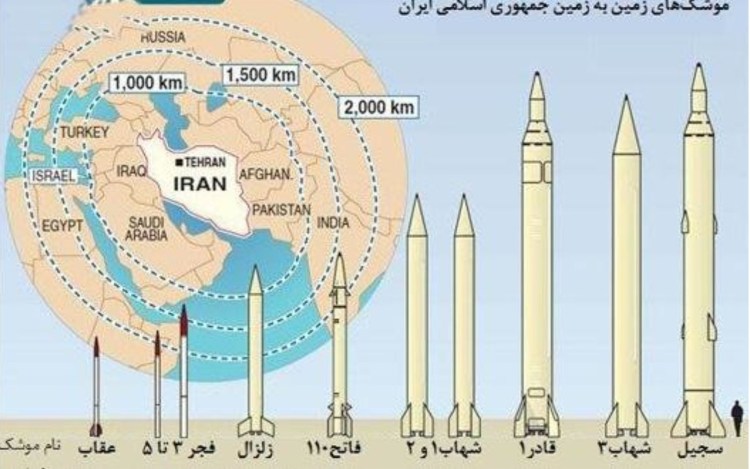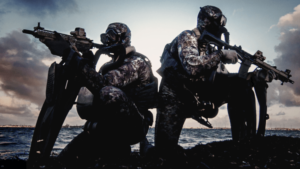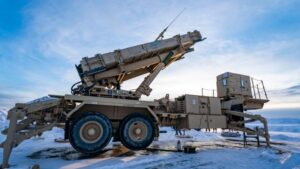From Conventional War to Shadow War
From 1980 to 1988, Iran fought Iraq in what is known as the “Iran-Iraq War.” during this bloody confrontation, it is estimated that over a million were killed on both sides, with Iran suffering the greater amount. According to Charles Kurzman (a professor at The University of North Carolina at Chapel Hill, specializing in Middle Eastern and Islamic Studies), Iran suffered 750,000 causalities, while Iraq suffered 500,000.
Photo Credit: Wikimedia Commons
For Iran, the big takeaway was that modern conventional war is costly, both economically and in terms of loss of life. At this point, strategic thinking shifted regarding how Iran’s military planners would confront its regional enemies.
Iran’s Arc of Resistance
Following the bitter and costly war, Iran would construct what is now known as its “Arc of Resistance,” running from Israel down to Yemen. The backbone of this arc would be Islamic militias funded, trained, and loyal to Iran. The key benefit of propping up these groups was that Iran could now put pressure on and, if necessary, fight its enemies with no threat to the Iranian regime or its homeland, as the group’s actions are deniable. The military repercussions would fall upon its proxy militias and their host nations, a win-win for Iran.
Photo Credit: DailyMail.com
According to the U.S. State Department, Iran provides $100 million annually to Hamas and other Palestinian groups annually. The House Committee on Financial Services states that Iran provides Hezbollah with $700 million, or 70 percent of its revenue. The author was not able to find the amount of funding for the Houthi movement. However, given that they receive large sums of weapons from Iran, they certainly receive monetary funding from Iran as well.
Hezbollah: Iran’s Premier Militant Group
While Israel is grinding down Hamas and may very well render its combat ineffective fairly soon, Hezbollah remains Iran’s primary and potent weapon to confront Israel. The group has 30,000 “active duty” fighters and 20,000 more in reserve, according to the Center for Strategic and International Studies.
Photo Credit: Tasnim News Agency | Wikimedia Commons (Photo of Hezbollah carrying out a training exercise in Aaramta village, in southern Lebanon, 2023)
As stated by the Congressional Research Service, Hezbollah has an estimated arsenal of 150,000 rockets, missiles, and drones. The most advanced weapons of this arsenal are precision-guided and pose a grave threat to Israeli infrastructure and the civilian population. Since the October 7, 2023, attack on Israel by Hamas, Hezbollah has fired nearly 7,000 missiles, rockets, and drones at northern Israel, according to Jotam Confino of the Telegraph. Israel has responded by striking Hezbollah targets within Lebanon, reportedly killing hundreds of Hezbollah militants.
Photo Credit: Center for Strategic and International Studies
The Killing of Ismail Haniyeh
The July 31, 2024, assassination of Ismail Haniyeh (chairman of the Hamas Political Bureau) in Iran has brought renewed threats from Iranian political leadership for strikes on Israel. We can take these threats very seriously, as Iran launched its first direct attack on Israel on April 14, 2024 (in response to the Israeli bombing of the Iranian consulate in Damascus, killing 13 Iranian officials).
Photo Credit: Federation Council | Wikimedia Commons | Photo of Ismail Haniyeh (Deceased as of July 31, 2024)
This attack involved 300 ballistic missiles, cruise missiles and suicide drones, this can be seen as a warning salvo. While this attack was neutralized via Israel’s missile interceptor network and allied aircraft, it marked an inflection point, as Iran displayed that it would directly attack Israel and that it has the capability and willingness to do so.
Photo credit: Center for Strategic and International Studies
How Could Iran Launch a More Robust Attack on Israel?
It now appears that Iran has begun to move missiles into position in preparation for another attack on Israel in response to Israel’s assassination of Ismail Haniyeh within Iranian territory. How could Iran carry out a more robust attack on Israel?
It is highly likely that Iran will use its proxy groups, particularly Hezbollah, as the first wave of attacks in order to attrite Israel’s missile interceptor network. Hezbollah could launch tens of thousands of missiles and rockets into Israel in multiple waves, overwhelming their ability to intercept further attacks, possibly supplemented by ground attacks with Hezbollah fighters.
Photo Credit: Sajjad Safari | Wikimedia Commons (Iran’s Great Prophet 2 Missile, 1,200 mi. range)
Following these initial and destructive waves of missiles and rockets, Iran could launch their Shahab 3, road-mobile, medium-range missiles. These missiles have a payload of 760 to 1,200 kg (2,645 lbs.) and a range of up to 2,000 kilometers (1,243 miles), giving them the ability to cover the entirety of Israel. The Shahab 3, given its lack of accuracy, would be aimed at Israel’s cities, larger military bases, and ports, reducing the probability of a miss. Given their payload, they could cause extensive damage to any target and hundreds of civilian deaths.
Conclusion
The April 14th Iranian attack on Israel was in response to the Israeli bombing of the Iranian consulate in Damascus. The July 31st attack was within Iranian territory, a much more severe offense. Seeing as that the first-ever attack on Israel by Iran involved 300 missiles, rockets, and drones, it would seem likely that the response to the Israeli attack within Iran itself will be more severe and costly for Israel (or that is the hope of Iran’s leadership).
If Iran and Hezbollah jointly attacked Israel, the attack would be overwhelming. While Israel can count on the United States and its partner states to assist it in its defense, it is difficult to believe that Israel and its allied assistance could stop every missile, rocket, and drone, as there realistically could be thousands and thousands of them. We have to take into account that Israel’s attack on Iran requires a massive response, or Iran will appear weak to its radical brethren, particularly since Israel is the most hated nation by these Muslim extremists.
Whatever the Iranian response is, it does not bode well for the stability of the Middle East, which, at present, is seemingly hanging by a thread. This, given Israel’s continued campaign against Hamas and the Houthi attacks on Red Sea shipping, has already created instability and economic repercussions. If a full-fledged war broke out between Israel, the entire region could burst into flames as it has the great possibility to draw in the U.S., obviously Iran, its terror proxies, and the surrounding states, which could be caught in the middle.
Keep your seatbelts buckled; it’s going to be a bumpy ride!!!
About The Author
Christian P. Martin is a Michigan-based military researcher and writer. He earned his Master’s degree in Defense and Strategic Studies from the University of Texas at El Paso. His professional interests are history, land, and naval warfare, both conventional and unconventional, with a focus on the developing world and an emergent China.
—
Disclaimer: SOFREP utilizes AI for image generation and article research. Occasionally, it’s like handing a chimpanzee the keys to your liquor cabinet. It’s not always perfect and if a mistake is made, we own up to it full stop. In a world where information comes at us in tidal waves, it is an important tool that helps us sift through the brass for live rounds.



